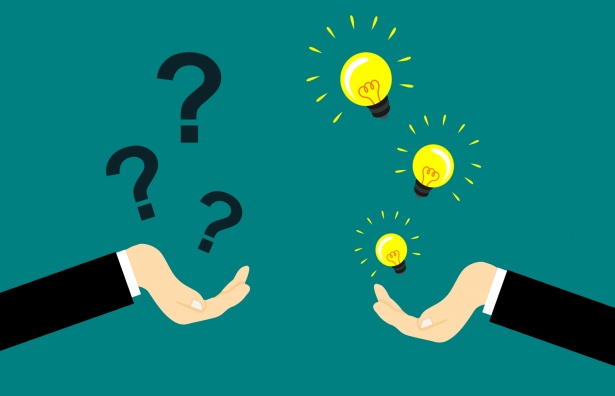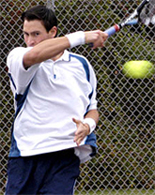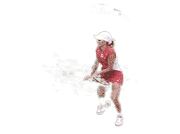Ask the Serve Doctor:
Common Serve Technique Questions
By Chris Lewit

Over the years, many parents started calling me "Doctor Lewit" or "The Serve Doctor" because of my ability to transform the serve technique of my players. The nickname stuck. This section answers common serve technique questions.
Should players use pinpoint stance or platform?
The platform stance and pinpoint stances can both be used to win pretty. The stance that a player uses is a personal decision. I teach both stances to my students and allow them to experiment with each stance to see which one feels best. I do not recommend forcing players to use one stance over another.
The best method is to try both stances and see what feels the best. Players who like the platform stance typically report that they feel more stable and like not having to make an extra foot movement. Pinpoint-stance devotees often report that they like the dynamic feel of that stance, and they feel more powerful in their leg drive with a step up to pinpoint maneuver.
There is an ongoing debate in tennis coaching circles about which stance is better and which stance provides the most powerful jumping platform. One study in 1983, by Bruce Elliott, a well-respected biomechanist, found that the platform stance produced more horizontal distance and the pinpoint allowed players to jump higher vertically (2). However, some analysts have criticized this study for flawed methodology.
Should women be taught the same as men?
According to Mark Kovacs and Todd Ellenbecker, "There are few significant differences in serve kinematics between professional male and female players, thereby eliminating the need to teach different mechanics to them (1). I agree, but based on my experience, petite women may not benefit from learning the kick serve, and are better off developing a faster, lower bouncing slice or hybrid topspin slice.
Should I use the same toss for all serves for better disguise?
Using the similar toss location is a very advanced skill that I work on with players after they have refined all the critical techniques in their serve. For developing players who are still learning the fundamentals, I recommend two tosses: a first serve toss out far in front of the baseline (1.5 to 2.5 feet) located between 12 and 1 o'clock and a second serve toss between 11 and 12 o'clock hovering closer to the baseline (less than a feet forward). This distance tossed in front depends on the height and reach of the player.
What are some simple keys to getting more power?
- 1.Good loading in the back leg and hip and trunk coiling before exploding upwards with the legs.
- 2.The proper timing of the racquet drop and leg drive to maximize the stretch-shortening cycle and elastic energy return.
- 3.Staying loose and elastic with the shoulder, elbow, and wrist.
- 4.Good contact point management with a toss forward into the court to allow early contact and weight transfer forward.
- 5.Full extension at impact maximizing energy transfer to the ball.
Where does the majority of power come from on the serve?
The shoulder and arm complex create the majority of the power. A player can stand without jumping and hit the serve very hard from a fixed position. Leg drive, trunk and hip rotation, lateral flexion/extension, also contribute additional power to the serve.
Should beginners start with racquet on back?
Starting with the racquet on or near the back should be avoided. Players should learn to pause in the L-shape or power position.
Should beginners stand on the ground and avoid using legs?
Many coaches advise learning to serve with the legs grounded. I have had excellent results getting kids to jump in a controlled way into the ball from the very beginning.
What is the correct footwork after the serve is completed?
There are two footwork sequences after the scorpion landing:
- 1.Scorpion move to split step.
- 2.Scorpion move to the jab step and then split step.
What grip should beginners use?
It's okay to use a forehand grip in the beginning. I like to focus on other bigger details like the leg drive, power position L-shape, contact point, scorpion landing, etc. Numerous other technical areas can be addressed before tackling the grip.
Is the same grip used for all serves?
Some pros use the same grip while others have a small shift in the palm or index finger position. It's okay to make a small change towards the top bevel to help impart topspin and slice. Just make sure the small change is imperceptible by the rival.
How do I develop the rhythm of the arms on the serve?
When working on tossing and achieving the L position, experiment with the different acceptable arm rhythms. Use what feels most comfortable. The key is getting into the L, not how you get there.
What serve should be learned or taught first?
The serves can be learned and taught in many different combinations or orders. The flat or slice serves are a good place to start; then add the kick serve mechanics onto that base of technique.
What age should a player learn a kick serve?
The kick serve can be learned at very young ages, below 10 years old (click here). The serve must be taught safely with no extreme tosses behind the back and lower back arch.
Please be careful teaching the kick serve to young kids whose bodies are still developing.
How many serves should I practice at one time?
Mark Kovacs recommends 60-100 balls at one time, and I agree (personal correspondence).
Does eye dominance affect the serve?
Care should be taken to make sure both eyes can track the ball binocularly and that one eye is not obscured by the body.
How do I keep my back and shoulder safe when serving?
Mark Kovacs recommends a good stretching and strengthening program, building good technique that's not extreme, and limiting the loads placed on the body during serve practice by confirming the number of balls during each session are not excessive (webinar). I agree.
Conclusion
In this series (click here), I conveyed my practical experiences learned from many years coaching the serve to my students. These experiences, along with guidance from biomechanical research, form the Winning Pretty way to build the serve. While there are many ways to build a good serve, the approach here is effective and evidence-based whenever feasible. You can use my method wholesale or take salient aspects and incorporate them into your own serving practice or teaching. I enjoy helping parent-coaches, coaches, and players build beautiful world-class serve technique. It's rewarding to see students master the most difficult stroke in the game of tennis by training the technical details piece by piece in a methodical way.
References
- 1.Kovacs M, Ellenbecker T. An 8-stage model for evaluating the tennis serve: implications for performance enhancement and injury prevention. Sports Health. 2011 Nov;3(6):504-13. doi: 10.1177/1941738111414175. PMID: 23016050; PMCID: PMC3445225
- 2.Elliott BC, Wood GA. The biomechanics of the foot-up and foot-back tennis service techniques. Aust J Sport Sci. 1983;3:3-6




